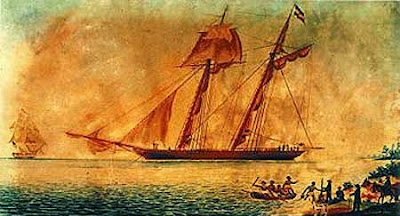Those
conspirators in Abraham Lincoln’s assignation, who were sentenced to death,
were hung July 7th 1865 at the Old Arsenal Penitentiary in Washington,
DC.
July 7th
1865 was a hot cloudless day, with temperatures reaching 100 degrees. General John F Hartranft read the death
warrant. Two soldiers standing under the
gallows built on the grounds of the Old Arsenal Penitentiary in Washington, DC,
knocked out the post holding the trap door on the gallows. It was 1:26 pm and the four convicted
conspirators; George Atzerodt, David Herold, Lewis Powell, and Mary Surratt,
dropped about five feet to their deaths.
They were left hanging about a half hour before being cut down. The bodies were laid on top of coffins and
doctors examined them to make sure each was dead. After this examination was complete they were
buried in shallow graves near the gallows.
It wasn’t long after that, that pieces of the
gallows would be taken as souvenirs. In
1867 the four bodied were removed and place in a nearby storage building. President Andrew Johnson had the bodies
returned to their families in 1869. No
one came for Lewis Powell’s body.
This is the
Death Warrant as read on July 7th 1865: War Department, Adjutant
General’s Office, Washington, July 5, 1865.
To Major
General W. S. Hancock, U.S. Volunteers, Commanding Middle Military Division,
Washington D.C.
“Whereas, by
the military commission appointed in paragraph A, Special Orders, No. 211,
dated War Department, Adjutant General’s Office, Washington, May 6, 1865, and
in paragraph 91, Special Order No 216, dated War Department, Adjutant General’s
Office, Washington May 9, 1865, and of which Major General David Hunter, U.S.
Volunteers is President, the following named persons were tried, and after
mature consideration of the evidence adduced in their cases were found and
sentenced as hereafter stated, as follows:
1st. David
E. Herold
Finding –
“Of the specification. Guilty except combining, confederating and conspiring
with Edward Spangler, as to which part, thereof, Not Guilty.”
“Of the
charge – Guilty, except the words of the charge that he combined, confederated
and conspired with Edward Spangler; as to which part of said charge; Not Guilty.
Sentence.“And
the commission does therefore sentence him the said David E. Herold, to be
hanged by the neck until he be dead, at such time and place as the President of
the United States shall direct, two thirds of the members of the commission
concurring therein.”
2d. George
Atzerodt.
Finding.
“Of the
specification Guilty, except combining, confederating and conspiring with
Edward Spangler: of this Not Guilty.”
Finding. “Of
the charge, Guilty, except combining, confederating and conspiring with Edward
Spangler; of this not Guilty.”
Sentence.“And
the commission does therefore sentence him, the said George A. Atzerodt, to be
hung by the neck until he be dead at such time and place as the President of
the United States shall direct, two thirds of the members of the commission
concurring therein.”
3d. Lewis
Payne.
Finding.“Of
the specification, Guilty, except combining, confederating and conspiring with
Edward Spangler: of this Not Guilty.”“Of the charge Guilty, except combining,
confederating and conspiring with Edward Spangler; of this Not Guilty.”
Sentence.“And
the commission does therefore sentence him, the said Lewis Payne, to be hung by
the neck until he be dead at such time and place as the President of the United
States shall direct, two thirds of the members of the commission concurring
therein.”
4th. Mary E.
Surratt.
Finding. “Of
the specification, Guilty, except as to receiving, entertaining, harboring, and
concealing Samuel Arnold, and Michael O’Laughlin, and except as to combining,
confederating and conspiring with Edward Spangler: of this Not Guilty.”“Of the
charge Guilty, except combining, confederating and conspiring with Edward
Spangler; of this Not Guilty.”
Sentence.“And
the commission does therefore sentence her the said Mary E. Surratt, to be hung
by the neck until she be dead, at such time and place as the President of the
United States shall direct, two thirds of the members of the commission
concurring therein.”
And whereas,
the President of the United States has approved the foregoing sentences in the
following order, to wit:“
Executive
Mansion, “July 5th, 1865. “
The
foregoing sentences in the cases of David E. Herold, G.A. Atzerodt, Lewis
Payne, xx, xx, xx, Mary E. Surratt, xxx, are hereby approved, and it is ordered
that the sentences in the cases of David E. Herold, G.A. Atzerodt, Lewis Payne,
and Mary E. Surratt, be carried into execution by the proper military authority
under the direction of the Secretary of War, on the seventh day of July 1865,
between the hours of ten o’clock a.m. and two o’clock p.m. of that day. x x x x
x x x ”
Andrew
Johnson, “Presd.”
Therefore,
you are hereby commanded to cause the foregoing sentences in the cases of David
E. Herold, G.A. Atzerodt, Lewis Payne, and Mary E. Surratt, to be duly executed
in accordance with the President’s order.
By command
of the President of the United States.
(signed)
E.D. Townsend, Asst. Adjt. Genl.

















